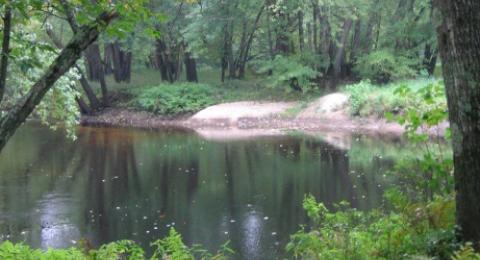
Over the years, New Hampshire’s floodplain forests have been cleared for development due to their proximity to river systems, and plowed under for agriculture due to their rich and productive soils. Intact floodplain forests contain uncommon plants and animals and are important reservoirs of New Hampshire’s biodiversity.
Floodplain forests usually occur in the low, flood-prone areas along rivers, typically less than 20 feet above the river channel. They are often associated with oxbows (pools that have become separated from the river channel), temporary wetlands that dry up in summer (vernal pools), open meadows of grasses and wildflowers, and dense shrub thickets. The periodic floods in these forests recycle sediment and nutrients, creating some of New Hampshire’s richest soil deposits.
Why are Floodplain Forests Important?
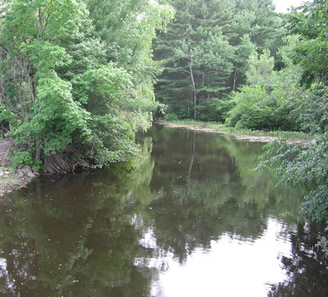 Floodplain forests are unique because of their periodic flooding.
Floodplain forests are unique because of their periodic flooding.
These regular disturbances, which deposit silt and sand along the banks of waterways, help create and maintain unique communities of plants that tolerate flooding and require nutrient-rich soils. Floodplain forests contribute many free ecological services to our society: they help filter pollutants to prevent them from entering streams, improve water quality, are critical in controlling erosion, and help buffer rivers against catastrophic flooding.
Floodplain forests as wildlife habitat
Floodplains are home to a diversity of wildlife. The damp soils create rich insect and amphibian breeding habitats, and these species in turn become prey for birds such as woodcock and barred owl, for mammals such as mink and raccoon, and for reptiles such as smooth green snake and wood turtle. Research in the Connecticut River region has shown that spring flooding thaws the soils of floodplain forests earlier than soils in surrounding areas. This early thaw means that insects become available to birds (as food) earlier in floodplain forests, so birds will feed in, follow, and depend more heavily on floodplain forests than other forested habitats during the early spring migration.
Floodplain forests as corridors
Floodplains provide corridors that allow wildlife to move from one habitat to another, especially in urban areas where development has fragmented alternative travel routes for wildlife. The overhanging canopy in floodplain forests also helps maintain cool waterways in the summer, which helps species such as brook trout.
Types of Floodplain Forest in New Hampshire
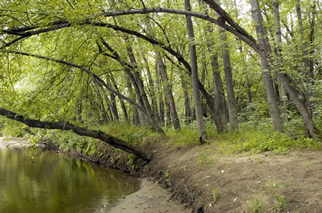 Southern New Hampshire
Southern New Hampshire
Along the Connecticut, Merrimack and other large rivers, floodplain forests consist of silver maple trees and a rich ground cover of wildflowers and ferns that thrive following large-scale floods that are common in these areas. Along smaller rivers in central and southern New Hampshire, floodplain forests contain mostly red maple trees, along with black ash, black cherry and ironwood growing among vernal pools, oxbows, and shrub thickets. Less common trees such as swamp white oak, sycamore, American elm, eastern cottonwood, and river birch can also be found in floodplain forests in southern New Hampshire.
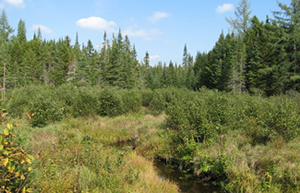 Northern New Hampshire
Northern New Hampshire
In northern New Hampshire and in the White Mountains, floodplain forests consist mainly of sugar maple and balsam fir. Due to the steeper topography in this region, these floodplains have quicker, faster floods, so the oxbows and vernal pools which are common along southern rivers are usually absent along northern rivers.
Threats to Floodplain Forests
 Agriculture & Development
Agriculture & Development
Human development of floodplain forests permanently eliminates habitat. Building and construction of paved roads may also separate wildlife populations, inhibit migration, create increased predation and promote collisions on roads. Paving areas of native floodplain forests lessens the water-storage capacity of the land, which can cause more frequent and catastrophic floods, with potentially drastic effects on wildlife, people, and communities downstream. Agriculture also has a negative impact on floodplains, but a less permanent one than human development. Over time, agricultural fields may revert to forest, and in their current condition they provide a different kind of habitat (hayfield, cropland) used by many wildlife species.
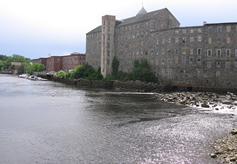
Impact of Dams
Dams on rivers prevent natural flooding, permanently altering the plant and wildlife communities of floodplain forests downstream. “Run-of-river” dams, which operate using available stream flow, not by storing water behind the dam, allow for normal flow except during periods of high water.
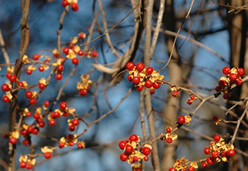 Invasive Plants
Invasive Plants
Invasive plant species spread easily in the frequent disturbances created by flooding and tend to thrive in the rich soils of floodplain forests. Particularly problematic are Oriental bittersweet, Japanese knotweed, and black swallow-wort, which can out-compete existing native vegetation, strangle trees or eliminate the tree canopy. Invasive plants may also directly impact floodplain wildlife. Research shows that berries from invasive plants such as bittersweet and buckthorn are lower in nutrition—like junk food for birds—than berries from native shrubs. (see Oriental bittersweet, at right)
Climate Vulnerabilities for Floodplain Forests
- Changes in precipitation patterns, such as longer periods of drought, unpredictable large storms, higher flows, and run-off events which can erode areas and change species composition.
- Increases in invasive species.
- Slow migration of southern species north.
Click here for the Floodplain Climate Assessment, a section of the Ecosystems and Wildlife Climate Change Adaptation Plan (2013), an Amendment to the NH Wildlife Action Plan
Wildlife Found in Floodplain Forests
- American black duck
- Baltimore oriole
- Belted kingfisher
- Blue-gray gnatcatcher
- Cerulean warbler
- Eastern red bat
- Green heron
- Jefferson salamander
- Northern leopard frog
- Otter
- Red-bellied woodpecker
- Red-shouldered hawk
- Silver-haired bat
- Wood turtle
- Yellow-throated vireo
Stewardship Guidelines for Floodplain Forests
- Focus land conservation in areas rich in existing floodplain systems, such as the Upper Ammonoosuc River (in Coos County--contains the most extensive boreal floodplain forests of balsam fir/sugar maple), the Middle Androscoggin River (in Coos County-- contains the most extensive silver maple floodplain forests in the state, and the Lamprey River (in Strafford County -- contains the most extensive minor river floodplain forests of red maple/shrubs in the state).
- Consider removing or modifying dams that alter the natural flood regimes of rivers. There are more than 5,000 dams in New Hampshire, many on private lands. If dams are removed or altered to become “run-ofriver” dams, restored natural flows can help maintain floodplain plant communities and benefit migratory birds and fish, amphibians, reptiles, and invertebrates that depend on seasonal flooding.
- Reduce recreational trails and roads within floodplain forests. These roads and trails can impede wildlife movement between wetland and upland habitats, especially during spring and early summer, when birds, amphibians and reptiles breed and young disperse from the river or nearby vernal pools into the surrounding upland areas. Trails can also provide an avenue for invasive plants to enter floodplain forests.
- Monitor healthy floodplain forests to prevent new infestations of invasive plants.
- Where feasible, consider controlling populations of invasive plants, recognizing that control will be necessary both upstream and downstream to prevent ongoing re-infestation. The New England Wildflower Society (newfs.org), UNH Cooperative Extension (extension.unh.edu) and other organizations offer training in invasive species identification and control.
- Forest management in floodplain forests should aim to regenerate existing floodplain species such as silver maple, balsam fir/sugar maple, or red maple. This may be problematic, however, if dams have altered the flood regime in a forest. Existing trees may be relics of past flood regimes, and regenerating species such as silver or red maple in the new, drier conditions may be difficult.
- Limit overstory removal of trees in floodplain areas where invasive plant species are present. Creating canopy gaps by timber harvesting can encourage invasive plant species to invade the disturbed areas; limiting the amount of light reaching the ground within floodplain forests can help discourage the establishment or spread of invasive plants.
- Always consult a licensed New Hampshire forester before conducting a timber harvest on your property. Understand and follow all laws pertaining to the harvesting of trees near wetlands and waterbodies. Follow established Best Management Practices, and harvest timber near wetlands only when the soils are either frozen (winter) or very dry (summer).
Additional Resources for Floodplain Forest
- Managing Riparian Forests: a UNH Cooperative Extension fact sheet about management in floodplain forests (also called "riparian forests").
- To learn more, read the NH Wildlife Action Plan habitat profile for Floodplain Forests, including information about the condition and location of this habitat, the threats facing this habitat, and conservation actions recommended by biologists to protect floodplain forests in New Hampshire.
- Publications related to Floodplain Forests
Photo Credits on this page: Ben Kimball, NH Natural Heritage Bureau; Malin Clyde; Dave Govatski.
Research for this webpage and accompanying Habitat Stewardship brochures was conducted by UNH Cooperative Extension staff with support from the Sustainable Forestry Initiative and NH Fish & Game
